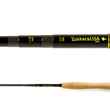When I was learning nymphing in the 1990s, it was commonly said that 50 percent of all strikes went undetected by the angler. In other words, half the time a trout ate your fly, you didn’t know it. Given the tools and approaches most often employed back then, I’d wager that estimate probably held water. But, more recently, technology—whether by producing advancements in fly rod construction and design or by facilitating an explosion in the exchange of ideas and information through online communication platforms—has driven a series of evolutionary jumps in fly fishing that have changed the way we fish. This phenomenon is perhaps best exemplified by the ever-accelerating Euro nymphing craze, where advancements in fly rod design have dramatically changed how naturally and effectively anglers can present flies below the surface where, it’s worth noting, trout do the vast majority of their feeding. Today’s nymphing angler can improve greatly upon the 50 percent rule of yesteryear. In fact, I’d venture to say that a talented angler using the right tools and approach, can detect most strikes—perhaps as much as 90 percent.
The right approach
Such a level of success using Euro-nymphing techniques is achieved through the use of a customized leader that enhances your ability to detect strikes, one that is a modification of—or evolution of—a “traditional” Euro-nymphing mono rig. If you’re not familiar with mono rigs, they involve using a very long leader which acts not only as your leader and tippet, but as your fly line, as well. That’s right, no fly line. But how do you cast a fly rod without fly line? That’s a good question. And so before we discuss our custom leader formula for better strike detection, we should talk about modern Euro-nymphing rods.
The right tool
Although there is no shortage of rods designed specifically for Euro-nymphing, I define a Euro-nymphing rod as one that is long and has a soft tip. The soft (often very soft) tips these rods feature offer two important advantages. First, softer tips enhance strike detection as more strikes are seen and felt with softer tips. Second, and equally important, softer tips allow anglers to cast light rigs because they require so little mass in order to load the rod. Traditional action fly rods are designed to cast fly lines, which have significant mass—making it incredibly difficult to cast long, light Euro leaders or mono rigs with traditional fly rods.
Go thin for the win
Most fly anglers are well-versed on the notion of slack. Depending on the situation and tactic being employed, an angler might want more or less slack in their fly presentation. Too little slack causes flies to move unnaturally in the water. Too much slack takes an angler out of touch with his or her flies, making hook sets and strike detection far more difficult. In the world of Euro-nymphing, slack is represented by sag. That is, the sag of your leader either between the tip of your rod and your flies, or between the guides of your fly rod. Any sag occurring within a Euro-nymphing rig both inhibits and delays strike detection. The less sag, then, the better. But, beyond using sound tactics, how do we reduce sag? The answer is by reducing mass.
The less mass hanging you have within and outside the guide of your fly rod, the less sag that occurs between you and your flies. The smaller the diameter of your line or leader, the less mass it will have. Smaller diameter lines also offer increased sensitivity, further enhancing strike detection. Many of today’s top Euro-nymphing anglers are using ultra-thin Euro leaders, where the thickest part of the entire line/leader setup may not exceed a 4X diameter!
The leader I’m currently using for most of my Euro-nymphing is constructed using a very simple formula. You can also feel free to substitute any of the materials — as long as you remain focused on keeping your leader thin through the use of low diameter materials.
The formula
Start with 30 feet or more of 6lb Maxima Chameleon tippet material. Although difficult to see, this material is much stiffer than traditional tippet material, which helps turning over ultralight nymphing rigs. If you find Chameleon’s disappearing act not to your liking, feel free to use more brightly colored monofilament. Next, add 2-3 feet of 4X Scientific Anglers Sighter material. Then, finish the leader with a level section of 5-7X tippet. That’s all there is to it.

I don’t use tippet rings with this ultralight system, as I feel that even the meager weight of the rings may introduce hinging. Instead, form my connections with surgeon’s or blood knots. If you prefer to use tippet rings, then go as small as possible to reduce mass.
To determine the length of the terminal tippet section, I guess at the average depth of the water I’m fishing and add 1-2 feet in length, to ensure the sighter material remains off the water. For example, if I guess the run I’m fishing to be around 3 feet deep, I’ll make my tippet section 4-5 feet long.
Wrapping Up
Using smaller diameter materials doesn’t just increase sensitivity, their lack of mass also allows your flies to sink faster and drift more naturally. In fact, when fishing this ultralight Euro leader, you might be amazed how little weight is required to drift nymphs deep in the water column. It’s for this reason that, even when fishing bigger water for large fish, I’ll often use 6X tippet.
If you find these thinner materials challenging to manage with your line hand, it may be best to start with somewhat larger diameters. Once you get the feel for things, graduate to thinner materials. Finally, take care to check local regulations to make sure monofilament-only rigs are legal on the waters you fish.































Comments
Mark Hayes replied on Permalink
Perhaps this question is obvious to some, but that does the Maxima Chameleon attach to? Fly line? Backing?
Chad Shmukler replied on Permalink
Mark Hayes replied on Permalink
Thanks Chad. That's what I suspected but it wasn't called out. Another question that came to mind: If you have 30' of Maxima leader material spooled up on your reel, does that mean that you spend 10 minutes stretching out 30' of leader and getting the coils out each time you fish? Maxima is good product, but it has a lot of memory.
Billy Rankin replied on Permalink
We have found Stren clear blue fluorescent in 20lb,17,lb,14lb is excellent and doesn’t tangle so much and I’ve ordered the 6lb on the author advice I use virtually the same set up but with tippet ring
Bill Rankin
Doug replied on Permalink
Check out Adams Euro nymph mono line. Very low memory, wonderful stuff.
Gabriel replied on Permalink
I attach my long thin mono leader to my fly line. That way you can switch to your fly line once the fish start looking up. However, this is indeed unnecessary if you intend to stick to nymphing.
Also, stretching the leader is useful before fishing, but it won't take you longer than a minute. You shouldn't get any proper coils anyway. Do pay attention not to step on your leader though, as this can easily lead to line breaks. Especially with studs.
Jon replied on Permalink
I just happened to catch george on the Oct 2023 orvis podcast. I believe he attaches this leader to the fly line loop so he can switch to dry fly fishing as needed. You can attach with as clinch knot.
kb replied on Permalink
My concern is losing casting distance when staying back from the fish. I taper from 12>10>8 then a 2x sighter with an 11ft rod. I wonder if micro is always better, and I suspect the answer is the usual “it depends.”
Glenn Dotter replied on Permalink
You young guys and newbees have been sucked in with the word "Euronymphing". Those of us "old" guys have been "high sticking" for years. But then thats what marketing does. Like "Tenkara" and "cane poles". Also take your knots and weigh them on a powder scale and the do the same with a tippet ring. You may be surprised.
Jon replied on Permalink
Have you found a tippet ring with 2 clinch knots is "competitive" with a triple surgeons or blood knot? I hope so as I prefer the ring....
DK replied on Permalink
May as well use a spinning rod.
John replied on Permalink
Why not go old school like I did when I was a kid, put a spinning reel on your fly rod? When the action moves to the surface we pulled out our fly reels swapped out the spinning reel and we were good to go.
Pages